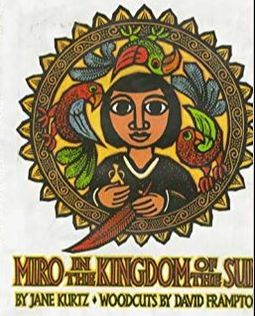|
I read this tale years and years ago and started looking for it about six years back. All I could remember was a handful of details. Then, recently, I came across it by accident. So technically I had the “Search for the Search for the Magic Lake.”
The story begins with an emperor whose son is dying. The emperor is desperate for a cure but can’t find one, until a disembodied voice tells him that his son can be cured by water from the magic lake at the end of the world. Many people search without success. Two sons of a poor farmer decide to try their luck, but like everyone else, they can’t find the magic lake. They decide to bring back some normal water – surely no one will be able to tell the difference! Shockingly, people can tell the difference and the emperor has them thrown into prison. This is a huge blow for the farmer and his family. However, they have one more child, a little girl named Súmac. In order to free her brothers, she decides to go in search of the lake herself. Along the way, she gives some of her food to some birds. The grateful birds each give her a feather, which she fashions into a fan. When she waves it, a great wind carries her all the way to the magic lake. It’s guarded by monsters, but she waves the fan again and they fall into a deep slumber. She has nothing to carry the water in, but at that moment, a mysterious golden flask appears. With another beat of the fan, she’s off to the palace. A few sips of water cure the prince instantly. The royal family is incredibly grateful and even asks Súmac to stay with them. All she asks for, however, is to free her brothers, return the feathers to the birds, and finally more land and livestock for her family. She returns home and her family lives happily in prosperity for the rest of their days. Genevieve Barlow studied Latin American culture and traveled widely. She heard this story in Quito, Ecuador, from the Inca Indians, during her travels. She doesn't give any further specifics. The heroine's name, Súmac, is probably from sumaq, the Quechua word for beautiful or good. It's a fairly unique tale, but there are many familiar motifs. For instance, the older brothers fail in their quest, but the youngest child wins the day - partly because of their kindness to animals. Often the youngest sibling is a boy, but there are variants with a little sister. As a child, I read one such story in an edition of the Arabian Nights: "The Two Sisters Who Were Jealous of Their Cadette." In the second half of the tale, two brothers and a sister embark one by one on a quest to find "The Talking Birds, the Singing Tree, and the Golden Water." The brothers are turned to stone, but youngest sister Periezade saves everyone. This is one of my favorite stories from that collection, but it's one of the dubious 18th-century additions by Antoine Galland. These additions include such famous tales as "Aladdin" and "Ali Baba and the Forty Thieves," which never actually appeared in the original Nights! Instead, Galland heard them from a Syrian man named Hanna Diab. They may have been influenced by European tales. Periezade's story fits perfectly into Aarne Thompson type 707, The Bird of Truth, a story already popular before Galland's work. Some examples of this type:
"The Magic Lake" doesn't fully fit into this type. It lacks the setup with the persecuted queen whose children are stolen. However, the plot of the two brothers who fail and the younger sister who saves them is the same. Talking birds frequently aid the heroine in this tale type. One of the goals of the quest is a spring or lake with magical healing properties. The other main part of "The Magic Lake" is the quest to save a dying prince. This, too, is a popular theme. For instance, "The Three Sisters" from Giambattista Basile's Pentamerone (1634) follows a heroine who slays ogres to heal a dying prince. (She has villainous older siblings, too.) "Kate Crackernuts" rescues a prince as well as her sister. Elements of the Ecuadorian story could have originated from European tales. However, it's a unique and memorable tale all on its own. Sources
Text copyright © Writing in Margins, All Rights Reserved
0 Comments
Leave a Reply. |
About
Researching folktales and fairies, with a focus on common tale types. Archives
July 2024
Categories
All
|
Writing in Margins

 RSS Feed
RSS Feed
